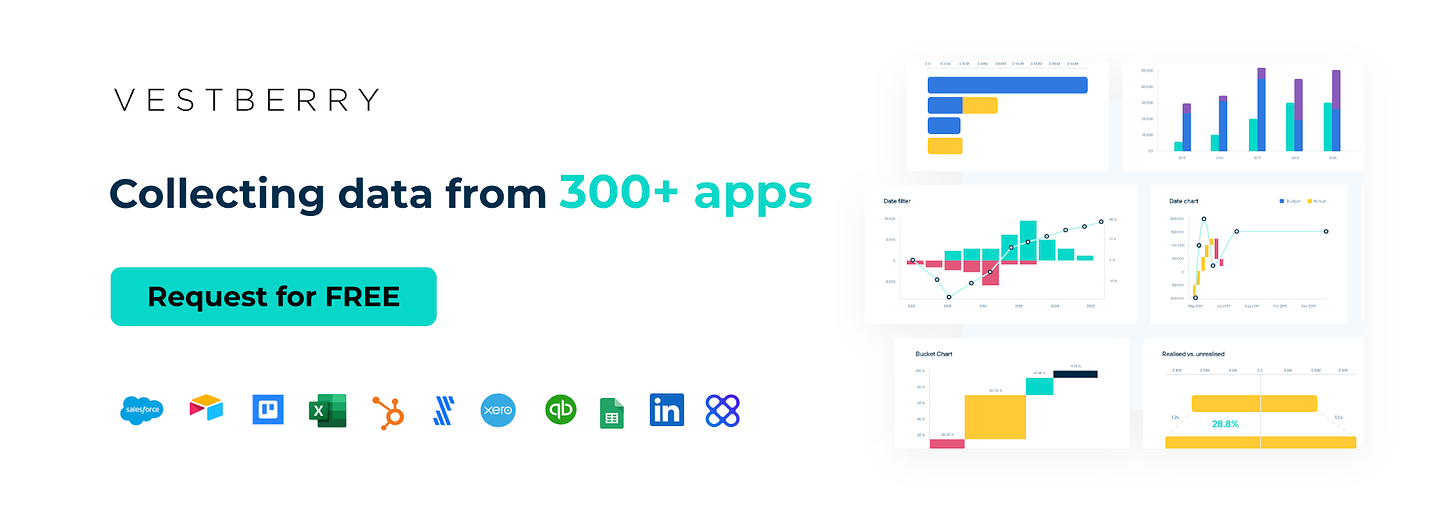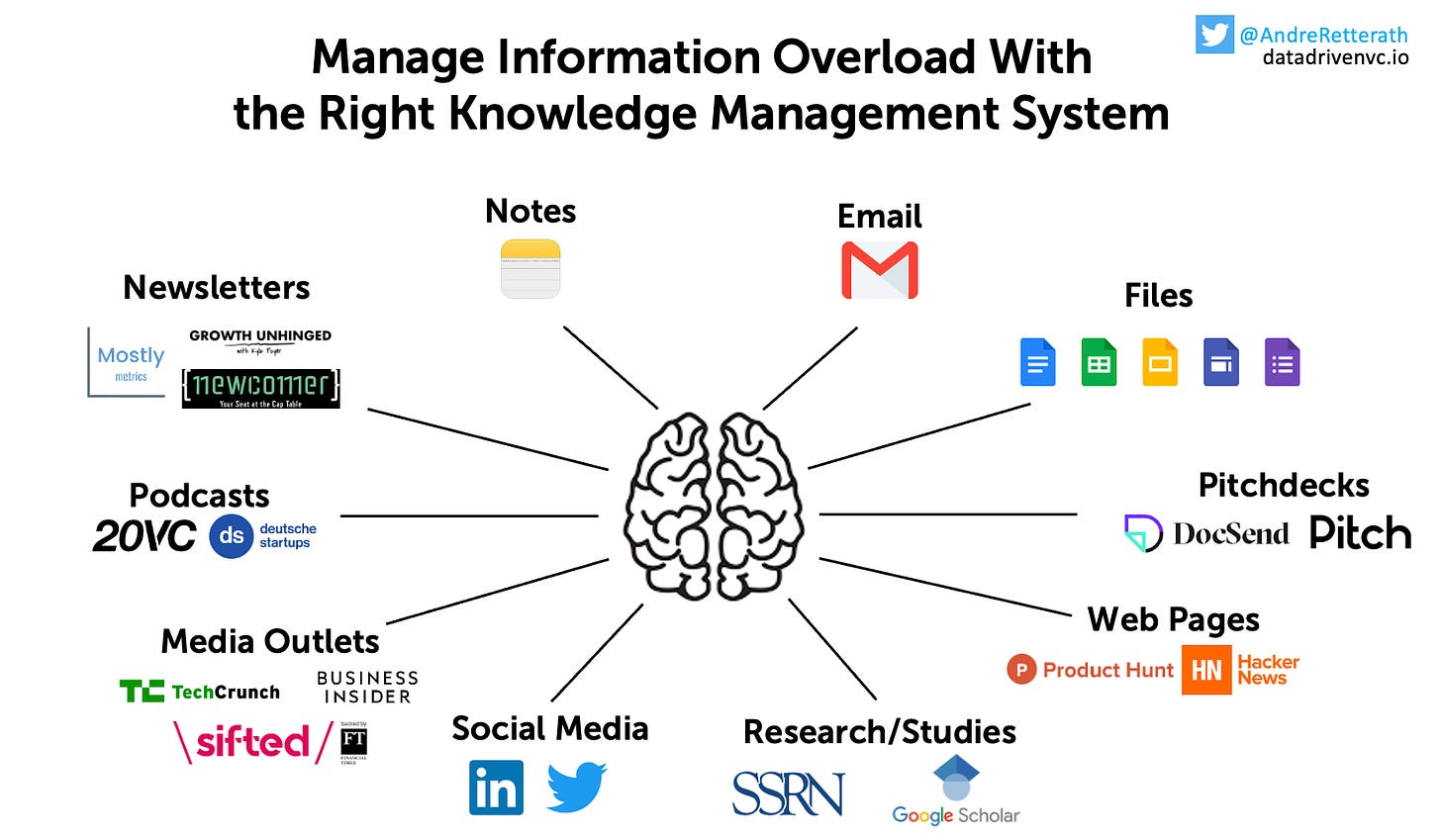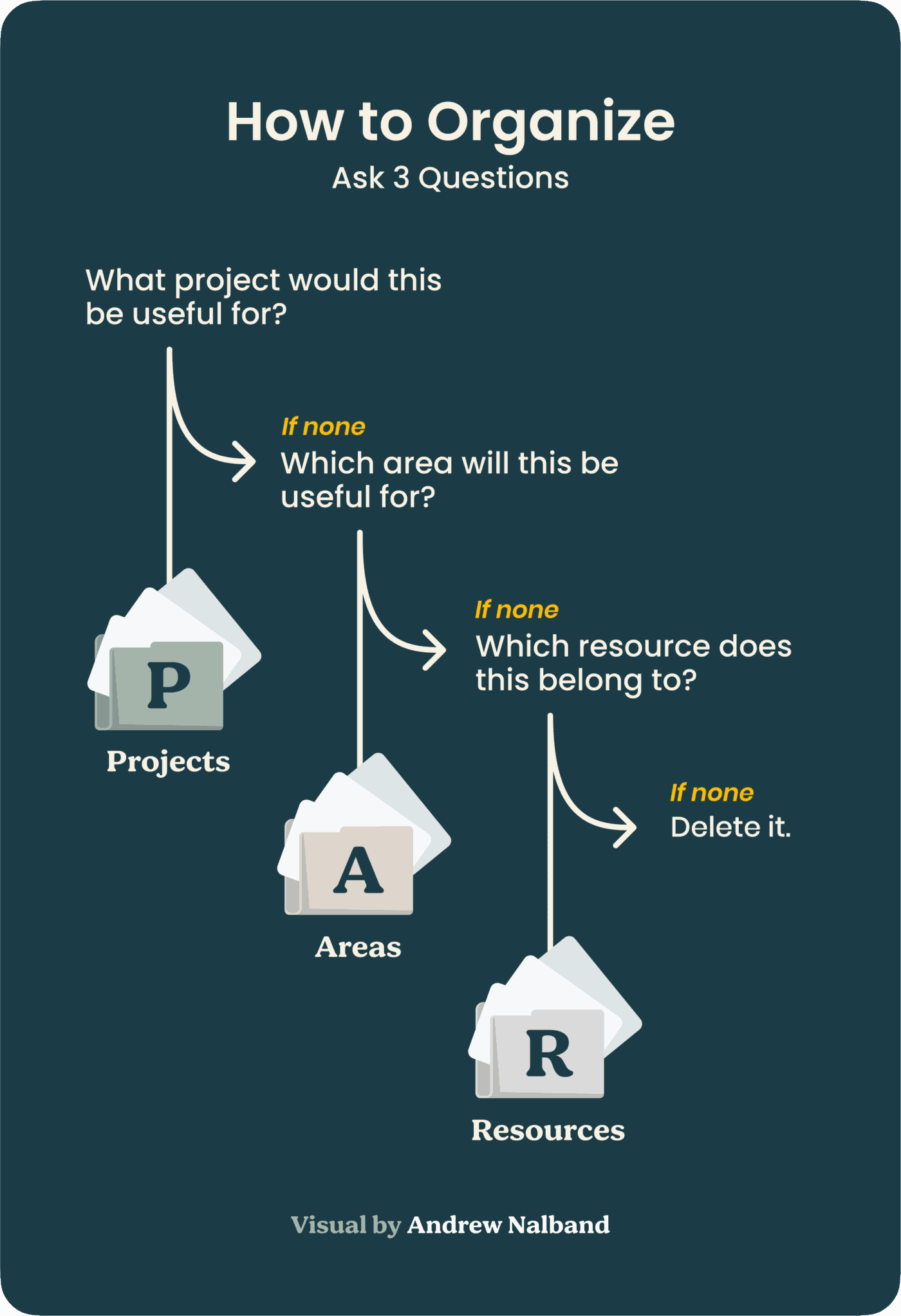Information Overload? Grow and Manage Your Knowledge with "Second Brain" System
DDVC #47: Where venture capital and data intersect. Every week.
👋 Hi, I’m Andre and welcome to my weekly newsletter, Data-driven VC. Every Thursday I cover hands-on insights into data-driven innovation in venture capital and connect the dots between the latest research, reviews of novel tools and datasets, deep dives into various VC tech stacks, interviews with experts, and the implications for all stakeholders. Follow along to understand how data-driven approaches change the game, why it matters, and what it means for you.
Current subscribers: 12,110, +250 since last week
Brought to you by VESTBERRY - A tool designed specifically for data-driven VCs
Request your FREE demo account to explore the potential of establishing live data links from over 300 diverse data sources, apps, and platforms, paving the way for distinctive VC insights.
In today's digital era, we find ourselves immersed in an unprecedented flood of information. With the rise of the internet, social media, podcasts, newsletters, and advanced communication technologies, we have access to an overwhelming abundance of data at our fingertips. It holds the potential for incredible knowledge and connectivity, but also presents a significant challenge: information overload.
In the context of last week’s introductory statement “Information is the currency of venture capital investors”, growing and managing knowledge is one of the key challenges (and most exciting drivers) as an investor. Attention is limited, so we need to maximize knowledge extracted per time, i.e. the ROI of knowledge workers.
Mastering this crucial challenge requires the right systems, otherwise, you won’t materialize your full potential and will be left far behind by your peers. Today, I’ll share a highly effective knowledge management system that every knowledge worker should know: Second Brain - a systematic approach to save and recall the ideas, insights, and connections we accumulate.
What is a second brain?
The concept of a Second Brain was popularized by Tiago Forte, a renowned productivity expert (book here). In essence, a Second Brain is an external, centralized, digital repository for the things you learn and the resources from which they come. It’s a system of knowledge that ultimately expands our memory and our intellect using modern tools of technology.
Why VC Investors Need a Second Brain
VC investors deal with vast amounts of information daily, including emails, pitchdecks, research articles, meetings, calls, podcasts, newsletters, LinkedIn posts, funding announcements, and a lot more. Properly processing and storing relevant information is key to staying on top of things, yet relying on conventional note-taking and bookmarking methods can be limiting and hinder the ability to access and synthesize information quickly.
Create your own Second Braind
Thankfully, there exists a simple framework to create an effective Second Brain via the CODE framework - Capture, Organize, Distil, and Express.
1) CAPTURE the ideas and content worth storing in the most efficient way. If you prefer to use multiple tools, then know which system is for what purpose (private, work, etc.) to keep everything in order. I personally use the following tools:
Note-taking via Apple Notes to store ad-hoc ideas and private notes (even offline) and Notion for all work-related notes. I also use Fathom (for Zoom) or the live transcription feature in Teams to transcribe calls, see example part #1 below.
Save to Notion to store passages or full web pages to Notion. It also works for social media content, newsletters, research papers, etc. - essentially for every piece of online content that has an individual URL.
Social media platforms allow you to bookmark or “star” something as a favorite and get back to it later. Start using these important features to curate your content feed.
2) ORGANIZE for easier searchability. I follow a simple rule: One note per item. For example, I create one note per company I talk to, then add segments for each person and call or meeting notes within the respective people paragraphs. In case you store information across different tools (like I do with Apple Notes and Notion), I advise merging them into one place (for me in Notion) and also pushing them into your team’s system of record/CRM system right away, either via copy & paste or via simple automation tools like Zapier.
Once all content flows together in one place, it won’t take long for you to become overwhelmed by an exploding amount of information. Although it’s tempting to create the most sophisticated folder structure from the get-go, trust me and start simple. Over time, it will naturally grow into the most effective structure. I’ve personally evolved and iterated my Second Brain in Notion for 5+ years.
If you’re just starting out, you might want to create a simple folder structure like “internal, external, portfolio companies, newsletters, HR, events, etc.”. Another framework I like a lot is the PARA framework which allows you to organize according to actionability with three simple questions.
Projects: short-term efforts (in your work or personal life) that you take on with a certain goal in mind
Areas: Long-term responsibilities you want to manage over time
Resources: Topics or interests that may be useful in the future
Archive: Inactive items from the other 3 categories
EXAMPLE PART #1: Call Transcript - Relevant to understand PART #2 below ;)
Andre: Hi Sarah, it's great to connect with you today. I've reviewed the materials you sent over about your startup, and I'm eager to learn more about your vision and progress.
Sarah: Hi Alex, thank you for taking the time to speak with me. I'm excited to share more about our venture. We are building a platform that connects local farmers directly to consumers, promoting sustainable agriculture and reducing food waste.
Andre: That sounds intriguing, Sarah. Could you walk me through your traction so far and any notable milestones?
Sarah: Of course! We launched our pilot program last quarter in two cities and managed to onboard 25 farmers and over 500 consumers. The feedback has been positive, and we're seeing steady growth in both user segments. Additionally, we've secured partnerships with two prominent local grocery chains, which will give us access to a broader consumer base.
Andre: Impressive progress for a pilot phase, Sarah. What sets your platform apart from other similar initiatives in the market?
Sarah: Our platform differentiates itself through a unique algorithm that optimizes the supply chain, ensuring the freshest produce is delivered to consumers while minimizing food waste. Furthermore, we have a strong focus on transparency, allowing consumers to trace the origin of the products they purchase and learn more about the farmers they support.
Andre: I like the emphasis on sustainability and transparency. Speaking of which, how do you plan to scale your operations in the coming months?
Sarah: Our expansion strategy involves launching in three more cities within the next six months. We've already identified potential markets with a thriving local farming community and a growing interest in sustainable food options. To facilitate this growth, we're actively seeking a funding round to invest in technology upgrades, marketing efforts, and team expansion.
Andre: That sounds ambitious, Sarah. Regarding your team, could you tell me more about the key members and their expertise?
Sarah: Absolutely. Our core team consists of myself as the CEO, with experience in agriculture and supply chain management. We also have a CTO with a strong background in developing logistics platforms, and a Head of Marketing who has successfully launched several food-related startups. Additionally, we have a skilled team of data analysts and customer support specialists.
Andre: It's evident that you've assembled a competent team. Now, let's discuss your revenue model and financial projections.
Sarah: Our revenue model primarily relies on a commission-based structure, where we take a percentage from each transaction made through our platform. We've projected steady revenue growth over the next two years, aiming to reach profitability within that timeframe.
Andre: Those projections look promising, Sarah. Before we conclude, can you share some insights into your fundraising plans and how you intend to use the capital?
Sarah: Our goal is to raise $3 million in this round. The funds will primarily be allocated to expanding our team and enhancing our platform's technology. Additionally, a significant portion will go towards marketing to fuel user acquisition in new cities.
Andre: Thanks for sharing your fundraising goals. Sarah, I'm quite interested in your startup and its potential. I'll be discussing this with my investment committee, and we'll be in touch for the next steps.
Sarah: Thank you so much, Alex. I really appreciate your interest in our vision. Please feel free to reach out if you have any further questions or need additional information.
Andre: Absolutely, Sarah. I'll be in touch soon. Best of luck with your venture, and talk to you soon!
3) DISTILL information to make it more actionable and easier to search for your future self. Besides the structure itself, I use ChatGPT to a) split notes, articles, papers, etc. into standardized structures, see example part #2 below, and b) create a summary for long-form content that I add at the top of the original content.
EXAMPLE PART #2: Process into a standardized structure
Summary: In this call, VC Investor Andre and Founder Sarah discuss Sarah's startup venture, which aims to connect local farmers directly to consumers, promoting sustainable agriculture and reducing food waste. They explore the company's traction, unique value proposition, team expertise, revenue model, and fundraising plans.
Problem/Market: Sarah's startup addresses the problem of inefficient supply chains and lack of transparency in the food industry. They aim to bridge the gap between local farmers and consumers while promoting sustainable practices.
Solution/Product: The startup's platform features a unique algorithm optimizing the supply chain for freshest produce delivery and focuses on transparency, allowing consumers to trace product origins and support local farmers.
Business Model: The company follows a commission-based revenue model, taking a percentage from each transaction made through their platform.
Traction: The startup has successfully completed a pilot program in two cities, onboarding 25 farmers and over 500 consumers. They have secured partnerships with local grocery chains and plan to expand to three more cities within the next six months.
Team: The core team consists of the CEO with experience in agriculture and supply chain management, a CTO with expertise in logistics platforms, and a Head of Marketing with experience in food-related startups, supported by a skilled team of data analysts and customer support specialists.
Funding Round: The startup aims to raise $3 million in this round, primarily for team expansion, technology upgrades, marketing efforts, and user acquisition in new cities.
4) EXPRESS unique knowledge and insights to create tangible results. Eventually, your Second Brain becomes a) the go-to source whenever your First Brain cannot properly remember some details, and b) you’d like to create new content (investment memorandum, trend analysis, blog post, etc.)
Having a substantial reserve of supporting material in your Second Brain eliminates the daunting task of sitting down to a blank page and struggling to conjure "something smart." In this repository, you stand on the shoulders of giants, benefitting from the wealth of brilliant ideas documented in your notes. This abundance of creativity from various sources becomes your wellspring of inspiration, fueling your own innovative thoughts and insights.
Conclusion
In summary, I use Apple Notes, Fathom, Teams Transcribe, Zapier, Notion, “Save to Notion”, and ChatGPT together with the CODE and PARA frameworks to grow and manage knowledge in my personal Second Brain. It’s a game changer for every knowledge worker and maximizes your ROI, i.e. knowledge extracted from a given amount of time/attention.
Stay driven,
Andre
PS: You might want to check the “Top 13 Chrome Plugins Every VC Should Use”
Thank you for reading. If you liked it, share it with your friends, colleagues, and everyone interested in data-driven innovation. Subscribe below and follow me on LinkedIn or Twitter to never miss data-driven VC updates again.
What do you think about my weekly Newsletter? Love it | It's great | Good | Okay-ish | Stop it
If you have any suggestions, want me to feature an article, research, your tech stack or list a job, hit me up! I would love to include it in my next edition😎









